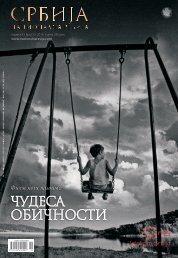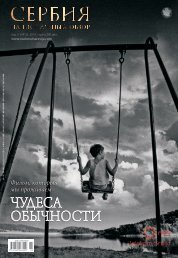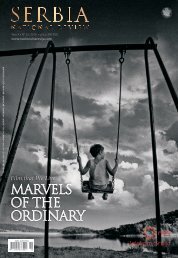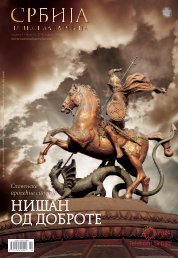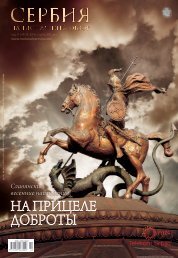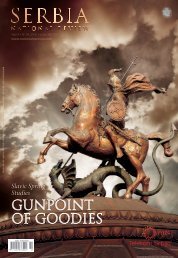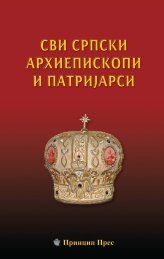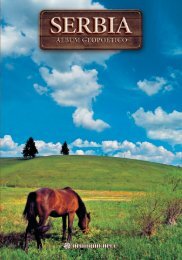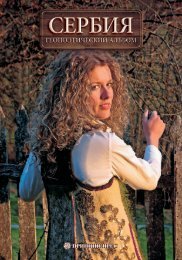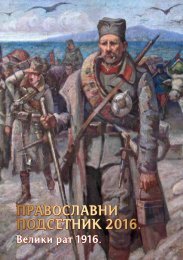Monografija - prvo izdanje - niska rezolucija
You also want an ePaper? Increase the reach of your titles
YUMPU automatically turns print PDFs into web optimized ePapers that Google loves.
У ма на сти ру Сту де ни ца краљ Ми лу тин по ди гао је цр кву<br />
Све тих Јо а ки ма и Ане, по зна ти ју као Кра ље ва цр ква. У овој цр кви<br />
ма лих ди мен зи ја по себ но се ис ти чу две сце не из жи во та Бо го ро дичи<br />
ног, Ро ђе ње и Ва ве де ње. Истих го ди на, сре ди ном дру ге де це није<br />
XIV ве ка, са зи да на је осли ка на ру ком Ми хај ла и Ев ти хи ја цр ква<br />
све тог Ни ки те у Чу че ру. Хро но ло шки сле ди цр ква све тог Ђор ђа<br />
у Ста ром На го ри чи ну са ве ли ким бро јем ци клу са, Ве ли ки Пра зници,<br />
Му ке Хри сто ве, Чу да и Па ра бо ле, Ме но лог, ци клус Све тог Ђорђа<br />
и дру ги. Двор ска сли кар ска ра ди о ни ца кра ља Ми лу ти на, на<br />
че лу са зо гра фи ма Ми хај лом и Ев ти хи јем, пре шла је из Ста рог<br />
На го ри чи на у по след њу кра ље ву за ду жби ну Гра ча ни цу.<br />
Свети Ђорђе из Каленића / Saint George, Kalenić Monastery<br />
Цр кву, у сред њем ве ку по све ће ну Бла го ве ште њу а данас<br />
Ус пе њу Бо го ро ди це, ма на сти ра Гра ча ни це мно ги сма тра ју<br />
нај леп шим срп ским сред њо ве ков ним хра мом. Вер ти ка ли зам<br />
је на гла шен сте пе на стом си лу е том гра ђе ви не, ко ја је кру ни сана<br />
ви со ким сре ди шњим ку бе том. У Гра ча ни ци је пр ви пут, по<br />
узо ру на ло зу Је се је ву пред ста вље на ло за Не ма њи ћа. Ис ти чу<br />
се и кти тор ски пор трет оста ре лог кра ља и ње го ве мла де супру<br />
ге Си мо ни де „у пур пу ру ро ђе не” ви зан тиј ске прин це зе.<br />
Краљ Ми лу тин об но вио је из те ме ља ка то ли кон ма насти<br />
ра Хи лан да ра. У исто вре ме пре у зе ти су и обим ни ра до ви<br />
на утвр ђе њу ма на сти ра, из гра ђен пирг Хру си ја са па ра клисом<br />
Све тог Спа са, а ма на стир ска имо ви на знат но је уве ћа на.<br />
По угле ду на ре ше ње ста ри јих све то гор ских цр ка ва у Ла ври,<br />
Иви ро ну и Ва то пе ду, хи лан дар ска глав на цр ква са гра ђе на је<br />
као раз ви је ни упи са ни крст, са две кон хе на боч ним стра на ма<br />
на о са и тро дел ним ол тар ским про сто ром.<br />
136<br />
Dragutin died in 1316, as monk Teoktist. He directed the painting<br />
of the narthex of the Đurđevi Stupovi Monastery. He adapted the<br />
ground floor of the entrance gate into a chapel that was painted<br />
with numerous historical scenes. The procession of members of<br />
Nemanjić dynasty is represented in the lower zones of the fresco<br />
program. The vault is painted with illustrations of four Serbian state<br />
councils, including the Council in Deževo where Dragutin passed on<br />
the throne to his younger brother.<br />
Dragutin was also the patron of the Church of St. Achilios<br />
in Arilje, which was the seat of the Moravica Archbishopric. The<br />
church was painted in 1296, and, in all likelihood, the painter<br />
came from Thessalonica. The frescoes are rendered on a blue<br />
background. It is a traditional painting with great number of historical<br />
portraits that form the basis of the iconographic schema.<br />
King Milutin, King Dragutin (holding the model of the church),<br />
Dragutin’s wife Katelina and sons Vladislav and Urošic are portrayed<br />
on the patrons’ composition in the narthex.<br />
The decades around the year 1300 were marked by the<br />
generous architectural endeavours of King Milutin (1282-1321).<br />
He had many endowments built in Serbia as well as outside of<br />
its borders: in Constantinople, Thessalonica, the Holy Land and<br />
on Mount Athos. The expansion of the Byzantine influence on<br />
the Serbian state developed in and amongst all areas of political<br />
and cultural life. The sacral buildings of this era are typically<br />
five-domed churches bearing a cruciform floor plan and built of<br />
stone and brick. Fresco painting in Milutin’s endowments developed<br />
alongside the frescos painted in Constantinople and Thessalonica,<br />
in a typical style of the era known as “the Palaeologan<br />
Renaissance” style.<br />
Among numerous churches of King Milutin, the Church of<br />
Bogorodica Ljeviška (Virgin Mary of Ljeviš) in Prizren deserves<br />
special attention. It was renovated in 1307 and painted a few<br />
years later by Mihailo Astrapa, a fresco painter who left an inscription<br />
in the narthex to note his work.<br />
During the period of 1309 till 1316,some of the painters<br />
of Bogorodica Ljeviška painted the frescos in the church in Žiča,<br />
repeating the paintings from the 13 th century that were ruined in<br />
the strike by Kumans.<br />
King Milutin built the Church of St. Joachim and Anna<br />
within the walls of the Studenica Monastery. It has small proportions<br />
and is better known as the King’s Church. In the painted<br />
programme two scenes depicting the Virgin Mary’s life, the Na



